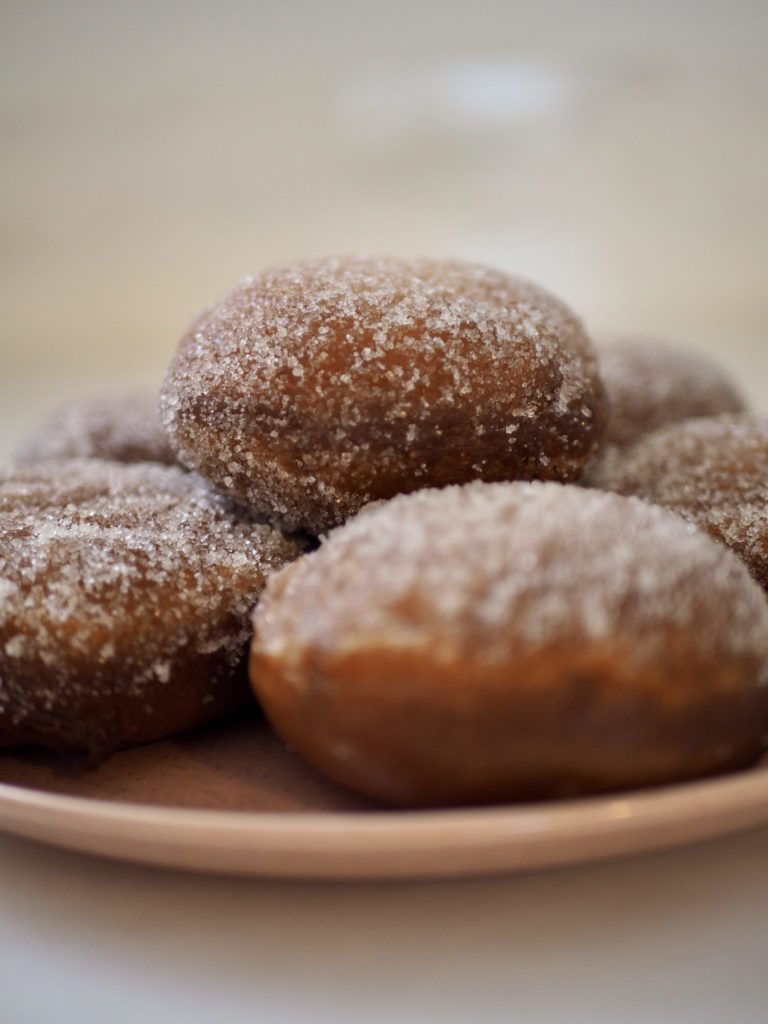
Share this post with another homeschool mom!
The Europeans who colonized America brought many traditions with them which are now interwoven into American culture. But they also brought several incredible recipes along with them, like classic doughnuts!
Week 5 of Dave Raymond’s American History course covers “Stability and Change: The Reformational Colonies”.
The Dutch who settled in the New England area in the late 1600s-early 1700s left their mark on this country in many ways. They contributed lots of names of cities and streets, words in our everyday language, and were the ancestors of powerful people like the Vanderbilts. But they also contributed something that, in American terms, is incredibly important; they gave us the recipe for doughnuts.
Historically the Dutch have always loved sweets and they brought recipes for all sorts of baked goods that Americans enjoy today. Their recipe for doughnuts was an instant hit in the colonies. Doughnuts are still made the same way today as they were back then, with one exception; known as “Olykoeks”, the Dutch didn’t cut a hole in their doughnuts but fried them in circles, thus the name “dough-nuts”. Only years later was the hole in the middle introduced to the classic dish, but the practicality of the hollow middle was quickly realized and has been around ever since.

Classic Doughnuts
- 1/2 c. milk, warm
- 1 1/4 tsp. active-dry yeast
- 1/8 c. water, warm
- 1/2 c. packed brown sugar
- 3-3 1/2 c. flour
- 1/2 tsp. salt
- 1/2 tsp. cinnamon
- 1 egg, beaten
- 1/2 c. (one stick) butter, room temperature
- 4 quarts of vegetable oil, for frying
- Combine warm water, yeast, and 1 tsp. sugar in small bowl. Let sit until frothy, about 5 minutes. In separate bowl combine flour, sugar, salt, and cinnamon and set aside. In a large bowl add milk, yeast mixture, and egg, then stir in flour mixture. Knead until all the flour is combined and the dough is stiff and heavy; add more flour if dough is too wet. Grease a large bowl, put dough in it, and cover with a dishcloth. Place dough in warm place for one hour or until doubled in size. I like to preheat my oven to 100 F then turn it off and let my dough rest there to make sure it’s in a warm spot the whole time.
- After dough has risen, punch down and place in bowl of stand mixer with a hook attachment. (You can do the next part by hand on a lightly floured surface, but I find that it gets pretty greasy and messy.) Cut the butter into 8 pieces and turn the machine on to level 2, kneading until all the butter is fully incorporated into the dough.
- Turn the dough onto a lightly-floured surface and roll out to 1/2” thick. Using a 2” cookie cutter or a wine glass, cut out doughnuts and place at least 1 1/2” apart on a baking sheet lined with parchment paper. Cover with dishcloth and let sit in warm place for 1 hour, until dough is puffed up and doubled its size by half.
- When dough is almost finished rising, pour vegetable oil in a large dutch oven and heat over medium-high heat until the temperature reaches 375 F. You can test this with a candy thermometer or put a small chunk of bread in the oil when you think it’s ready. If the bread sizzles and turns brown, the oil is hot enough.
- Line a plate with paper towels. Fry just one doughnut first, to make sure oil is hot and to get a feel for how long you should fry the doughnut on each side. The doughnuts should be nicely browned on each side, taking 60-75 seconds each side to cook, and shouldn’t be dough-y inside. Remove doughnut from oil and sprinkle with sugar. If you think you’ve gotten the hang of it, place up to three doughnuts in the oil and fry evenly on both sides, repeating until finished. Serve warm and enjoy!
Share this post with another homeschool mom!












